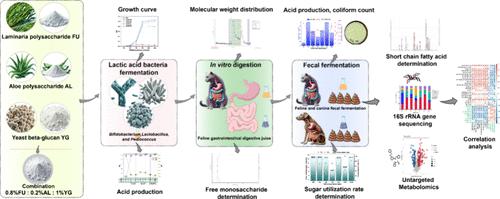三种多糖对猫和狗肠道微生物群的调节作用:来自体外消化、粪便发酵和乳酸菌发酵的见解
IF 6.2
1区 农林科学
Q1 AGRICULTURE, MULTIDISCIPLINARY
引用次数: 0
摘要
本研究评价了海带多糖(FU)、芦荟多糖(AL)和酵母β-葡聚糖(YG)对猫、犬体外消化、粪便发酵和乳酸菌发酵的影响。FU (Mw 27 713 g/mol)、AL (44 425 g/mol)和YG (29 296 g/mol)主要由葡萄糖、半乳糖醛酸和葡萄糖醛酸组成。FU对双歧杆菌、乳杆菌和Pediococcus的发酵有很强的促进作用。AL微支持乳酸杆菌。YG表现出最小的活动。消化后分子量下降,单糖释放可忽略不计。FU和AL在粪便发酵过程中几乎被完全代谢,而YG的利用率为~ 50%。FU产生的乳酸浓度最高。YG显著增加了SCFA水平,特别是在犬中,超过了低聚果糖。以FU:AL:YG (0.8:0.2:1, FAY)的混合料综合效果最好。16S rRNA分析显示scfa产生属(如Megamonas, Parabacteroides)的富集和气味相关细菌(如Fusobacterium, Desulfovibrio)的抑制。代谢组学显示,气味化合物(如2-氧吲哚,5-羟基吲哚)水平降低,次生胆汁酸(如脱氧胆酸,糖胆酸)水平增加。FU、AL和FAY上调胆汁分泌、神经活性通路和花生四烯酸代谢,而YG激活ABC转运蛋白通路。本文章由计算机程序翻译,如有差异,请以英文原文为准。

Regulating Effects of Three Polysaccharides on Gut Microbiota in Felines and Canines: Insights from In Vitro Digestion, Fecal Fermentation, and Lactic Acid Bacterial Fermentation
This study evaluated the effects of laminaria polysaccharide (FU), aloe polysaccharide (AL), and yeast β-glucan (YG) on in vitro digestion, fecal fermentation, and lactic acid bacterial fermentation in felines and canines. FU (Mw 27 713 g/mol), AL (44 425 g/mol), and YG (29 296 g/mol) were primarily composed of glucose, galacturonic acid, and glucuronic acid. The FU strongly promoted the fermentation of Bifidobacterium, Lactobacillus, and Pediococcus. The AL slightly supported Lactobacillus. The YG showed minimal activity. Molecular weights decreased after digestion with negligible monosaccharide release. The FU and AL were almost completely metabolized during fecal fermentation, while YG had ∼50% utilization. The FU produced the highest lactate concentration. The YG significantly increased SCFA levels, especially in canines, surpassing fructooligosaccharides. The FU:AL:YG mixture (0.8:0.2:1, FAY) achieved the best overall effects. 16S rRNA analysis revealed the enrichment of SCFA-producing genera (e.g., Megamonas, Parabacteroides) and suppression of odor-related bacteria (e.g., Fusobacterium, Desulfovibrio). Metabolomics showed reduced levels of odor compounds (e.g., 2-oxindole, 5-hydroxyindole) and increased secondary bile acids (e.g., deoxycholic acid, glycocholic acid). The FU, AL, and FAY upregulated bile secretion, neuroactive pathways, and arachidonic acid metabolism, while YG activated the ABC transporter pathway.
求助全文
通过发布文献求助,成功后即可免费获取论文全文。
去求助
来源期刊
CiteScore
9.90
自引率
8.20%
发文量
1375
审稿时长
2.3 months
期刊介绍:
The Journal of Agricultural and Food Chemistry publishes high-quality, cutting edge original research representing complete studies and research advances dealing with the chemistry and biochemistry of agriculture and food. The Journal also encourages papers with chemistry and/or biochemistry as a major component combined with biological/sensory/nutritional/toxicological evaluation related to agriculture and/or food.

 求助内容:
求助内容: 应助结果提醒方式:
应助结果提醒方式:


